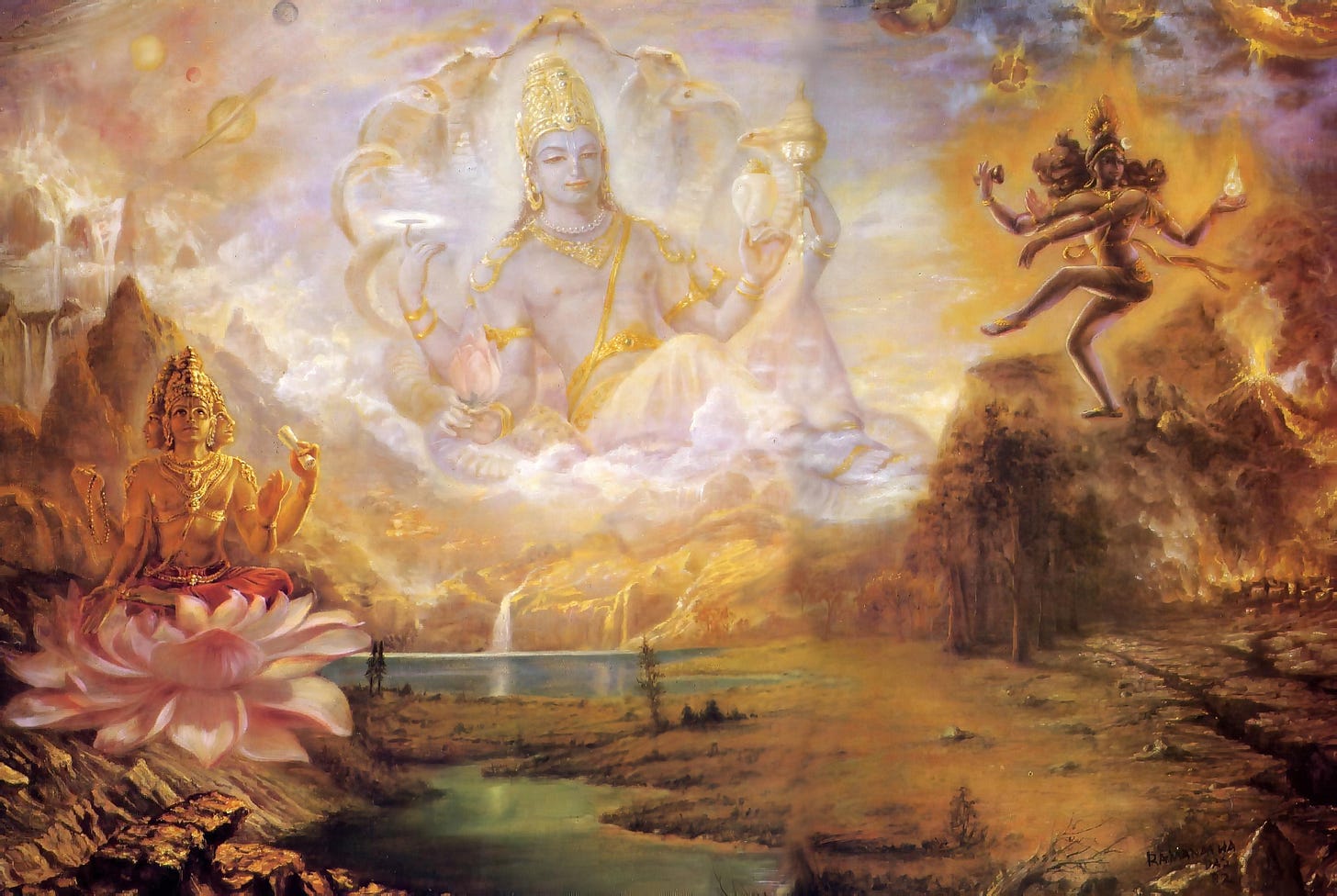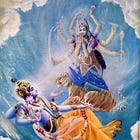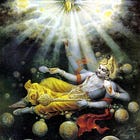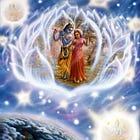Brahma populates the universe
Brahma hoped that the four Kumāras would create progeny and help him to fill up the universe, but being so pure, the Kumāras were transcendentalists who were not interested in such work.
It’s mentioned in the Srimad Bhagavatam that when Brahma started the process of creating the universe, he started by creating illusory engagements, such as self-deception, the sense of death, anger after being frustrated, the sense of false ownership, and the illusory bodily conception (that makes one forget his real identity as a soul). It’s easy to understand why such influences were created first, since they constitute the basis of conditioned life in this material world. If one does not identify with the body and believes he possesses things in this material world, what is the possibility of remaining conditioned here? These are influences that affect all conditioned living beings.
Although necessary for the workings of the universe, Lord Brahma was not very pleased with such activities; therefore, he decided to purify himself by meditating on Lord Vishnu before starting another term of creation. With such an elevated mentality, he engaged himself in the creation of the four Kumāras, who are almost completely pure.
Brahma hoped that the four Kumāras would create progeny and help him to fill up the universe, but being so pure, the Kumāras were transcendentalists who were not interested in such work. They didn’t even want to grow up, preferring to stay as small children, thus avoiding the possibility of falling under sexual urges.
It is described that the four Kumāras were unwilling to adopt materialistic activities because they were highly elevated due to their semen flowing upwards. In Ayurveda, semen is described as the quintessence of food, the last transformation of the nutrients absorbed by the body, and the giver of life. If one preserves his semen, he can greatly increase his vitality, intelligence, duration of life, and so on. This is particularly useful for one interested in advanced study of the Vedas and renounced life, like in the case of the Kumāras. To avoid the possibility of becoming later involved in sexual activities, the Kumāras used their yogic power to remain as small children.
Because the four Kumāras were so spiritually elevated, Brahma entrusted to them the four principles of knowledge that compose the jñāna-kanda section of the Vedas:
1) Sāṅkhya: The analytical study of the material world to become free from it. This philosophy was later explained in detail by Lord Kapila.
2) Yoga: The path of mysticism to attain liberation from the material world. “Yoga” is a generic word that can be applied to any process that helps us connect with Krsna, but here the word applies to the process of mystic yoga.
3) Vairāgya: The process of detachment from materialistic life to attain spiritual understanding.
4) Tapas: Various kinds of voluntary austerities performed to attain spiritual perfection.
The four Kumāras preside over the planetary system of Tapoloka, which is immediately under Satyaloka, the planet of Brahma. In the Bṛhad-bhāgavatāmṛta, it is described that this planetary system is inhabited only by great sages, who are promoted there after being perfect brahmacaris for many lives. They are fully renounced and spend most of their time in samādhi, seeing Paramātmā inside their hearts. They rarely talk, and when they do, it is exclusively to have some philosophical discussion. The Kumāras disseminate this knowledge they received from Brahma all over the universe. Later in the Srimad Bhagavatam, it is described how they instructed King Pṛthu, for example. They are also the founders of the Kumāra Sampradāya, one of the four Vaishnava disciplic successions.
It’s also interesting to note that although Sarasvatī Devi (the Goddess of learning) is generally considered the consort of Lord Brahma, their relationship is not sexual. Sarasvatī Devi is like the energy of Lord Brahma, connected with the understanding of Vedic knowledge, helping him to understand Krsna, just like she helps other souls in the material universes to understand Vedic knowledge. We have information that in the spiritual world, there are also couples, but their relationships are centered on their devotional service. In other words, in the spiritual world, the focus of the relationship is the service to Krsna, and not just mutual satisfaction like here in the material world. Although anatomically complete, they consider sexual relationships distasteful and don’t engage in them. This cooperation between Brahma and Sarasvatī Devi is a good example of how relationships can be purified, even while we are still inside this material universe.
Lord Brahma performs his service of creation by just meditating in the forms he desires to create, but other beings in this universe create progeny through the sexual act. Brahma desired that his sons, the four Kumāras, would get married and help him in his service of populating the universe, but when they refused, Brahma became angry, and from between his eyebrows came Lord Shiva, in the form of a child of mixed blue and red hue.
The Vedas appear
At a certain point, as he meditated on how to re-create the universe as it was before, the four Vedas emanated, each from one of Brahma’s mouths. With the Vedas, different types of paraphernalia for executing sacrifices, as well as truth, austerity, mercy, and cleanliness (the four principles of religiosity), and the duties for the four social classes (brāhmana, kṣatriya, vaiśya, and śūdra).
The four Vedas were followed by all the other groups of knowledge that are part of the Vedic literature, such as medicine, military science, musical art, architecture, and so on. All the different branches of knowledge derive from knowledge from the Vedas. The word “Veda” in itself means “knowledge”. All knowledge that exists comes originally from Lord Mahā-Viṣnu and is transmitted to different inhabitants of this universe through the disciplic succession, starting from Lord Brahma. These different branches of knowledge become available or unavailable in human society at different times, as the knowledge is revealed by great personalities and later gradually forgotten.
The Vedas include all types of knowledge because everything that exists was originally created by Lord Mahā-Viṣnu as part of the primary creation. Different living beings just receive this knowledge from inside the heart or rediscover things that were already created by the Lord in the past by some process of experimentation. One may create a plane, for example, but such a creation is only possible because the Lord conceived the plane in the past, just as everything else that exists, existed, or will exist in the future.
All technical and artistic knowledge we have nowadays is also originally part of the Vedas; it’s just that, instead of receiving this knowledge through disciplic succession, in modern society, we try to obtain it through different processes of experimentation. In this way, all we do is just slowly rediscover bits of knowledge that were originally part of the Vedas, a much slower and more difficult process. On SB 2.7.34, for example, it’s mentioned how, in a different Kali-Yuga, human beings were able to receive advanced Vedic technical knowledge from Maya Dhanava and thus built very advanced, invisible spaceships, on which they were able to invade other planets. This led to one of the appearances of Lord Buddha, who came to teach them non-violence. This shows how Vedic knowledge includes all branches of knowledge, including advanced technical knowledge that we don’t have access to at the current times.
On SB 3.12.39, it’s mentioned that Brahma also created the Itihasas, including the Puranas and the Mahabharata. One could question how this can be possible since we are speaking about events that happened at the beginning of Brahma’s day, while books such as the Mahabharata speak about events that happened much later. Answering this question, the verse includes the words “sarva-darśanaḥ”, indicating that Lord Brahma can see the past, present, and future, and can thus speak about events that will happen in the future, just like we may discuss events that are happening now.
We can see that in the 7th chapter of the 2nd canto, at the beginning of his current day, Lord Brahma gives Nārada Muni a list of the incarnations of Krsna that appeared only later on, including Krsna appearing in Vrindavana 5,000 years ago. This shows how great personalities like Lord Brahma have a different view of time: although they go through their lives just like we do, all the events that are about to happen are already known to them. However, being detached, they understand the power of providence and don’t try to change what is going to happen.
It is described that later on, Brahma also created the duties for the four spiritual classes (brahmacārī, gṛhastha, vānaprastha, and sannyāsa), and thus completed the revelation of the varnāśrama system, which is followed by all advanced societies around the universe. In this connection, it’s interesting to note that although nowadays we consider ourselves quite advanced, our current society is not considered very elevated from the point of view of the inhabitants of other planets. In reality, during the age of Kali, our planet is avoided by advanced personalities from other planets, being essentially quarantined. However, it was not always like that. In previous ages, it was common for great sages, demigods, and other advanced personalities to visit our planet to attend ceremonies or transmit Vedic knowledge.
Read also:






Hare Krishna Prabhu ji 🙏 very well presented and enlightening article. Thank you so much Prabhu for this great service .